SDTEST® has 38 different VUCA polls that calculate the 13,643 correlation values between stages of development according to the theory of Spiral Dynamics and answer options of these 38 polls.
We invite curiosity about the systemic mechanisms behind this correlation. There may be hidden variables that provide alternative explanations.
In our analysis of the poll "AI and the end of civilization" (Elon Musk), we found an intriguing negative linear correlation that warrants closer examination:
-0.0826 (Pearson) between the State should exercise control over the development of artificial intelligence / Somewhat disagree and the Purple stage.
The critical value of the correlation coefficient for a normal distribution, by William Sealy Gosset (Student), is r = 0.0688. Nevertheless, this negative linear correlation of -0.0826 meets the reliability criteria but does not necessarily imply causation.
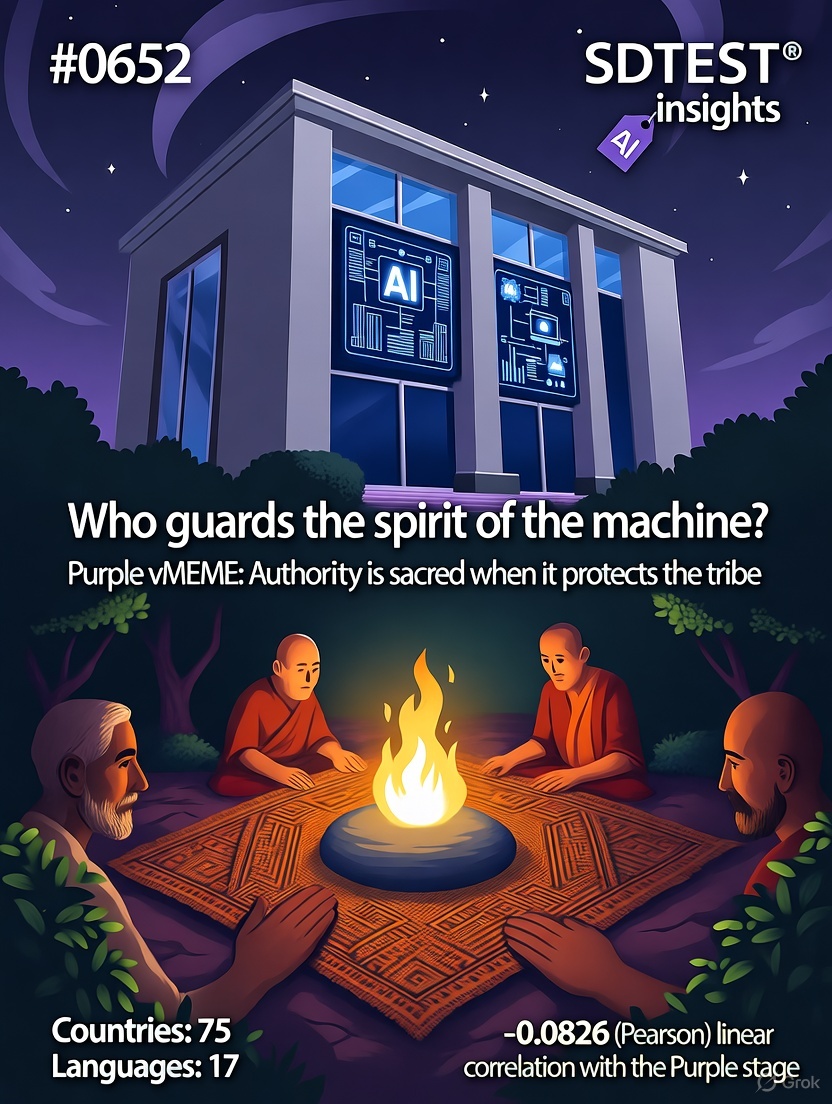
This negative correlation of -0.0826 between "State should exercise control over the development of artificial intelligence / Somewhat disagree" and the Purple stage offers profound insights when viewed through the lens of the Purple value system. This correlation indicates that the stronger the Purple values, the LESS likely people are to disagree with state control over AI development, meaning they SUPPORT such oversight.
Organizational Perspective:
Organizations operating within the Purple mindset might interpret this correlation as:
- Validation of their ancestral wisdom that powerful new forces and mysterious technologies must be controlled by tribal chieftains and spiritual authorities to prevent angering the gods
- Confirmation that their traditional leadership structures recognize artificial intelligence as a supernatural force requiring oversight from those blessed with divine authority and ancestral guidance
- Evidence supporting their belief that allowing unchecked development of mystical machine powers without tribal elder supervision could bring catastrophic spiritual consequences upon the community
These organizations might respond by:
- Demanding that tribal leaders and shamans be consulted before implementing any artificial intelligence technologies within the organization
- Performing protective rituals and ceremonies to ward off potentially harmful spirits inhabiting artificial intelligence systems
- Establishing taboos and sacred protocols requiring state or tribal authority approval before adopting any AI technologies that might disturb ancestral harmony
Team Perspective:
Teams operating from a Purple mindset might approach this correlation by:
- Viewing it as an affirmation from ancestral spirits that mysterious artificial intelligence forces must be controlled by legitimate authorities to protect the tribal community
- Interpreting it as support for their belief that without proper oversight from spiritual leaders, AI could unleash supernatural chaos upon their team and clan
- Seeing it as validation for trusting in higher authorities—both earthly chiefs and divine powers—to protect them from dangerous mystical technologies
These teams might respond by:
- Seeking guidance from tribal elders and spiritual advisors about whether artificial intelligence carries dangerous spirits or supernatural threats
- Conducting protective rituals before engaging with any AI technologies to ensure ancestral blessing and divine protection
- Creating team customs that honor state and tribal authority over mysterious technologies that might threaten their sacred community bonds
Individual Perspective:
Individuals aligned with the Purple value system might interpret this correlation as:
- Personal validation that their instinctive fear of uncontrolled artificial intelligence reflects ancestral warnings about unleashing forces beyond human spiritual comprehension
- Evidence supporting their belief that only divinely-appointed authorities and tribal leaders possess the spiritual power to control dangerous mystical forces
- Confirmation that their trust in state control reflects proper respect for the hierarchical order established by ancestors and blessed by protective spirits
These individuals might respond by:
- Seeking protection from shamans and spiritual leaders against the potentially malevolent spirits dwelling within artificial intelligence systems
- Supporting state control over AI as a sacred duty to prevent supernatural catastrophe that could anger ancestral spirits
- Performing personal rituals and carrying protective talismans when exposed to artificial intelligence technologies
This correlation, viewed through the Purple lens, suggests that those operating at the Purple level see artificial intelligence as a mysterious supernatural force requiring oversight from divinely-sanctioned authorities.
The reasons why people with strong Purple values support (rather than disagree with) state control over AI development could include:
- Ancestral Protection: Believing that mysterious new forces must be controlled by legitimate authorities blessed with spiritual power to protect the tribe from supernatural harm
- Divine Hierarchy: Understanding that only those with ancestral blessing and divine authority possess the spiritual strength to control dangerous mystical technologies
- Supernatural Fear: Viewing artificial intelligence as potentially inhabited by malevolent spirits or forces that require sacred oversight and protective rituals
- Tribal Safety: Recognizing that uncontrolled development could unleash chaos that threatens the spiritual harmony and physical safety of the entire community
- Sacred Order: Believing that state control reflects the proper cosmic hierarchy where earthly authorities channel divine wisdom to protect against mysterious dangers
This correlation prompts us to consider how traditional spiritual value systems perceive emerging technologies through frameworks of supernatural danger and divine authority. It raises questions about the relationship between ancestral wisdom, spiritual protection, and technological governance in Purple-dominant consciousness.
Ultimately, this correlation highlights the complex interplay between spiritual beliefs, tribal safety, and technological oversight. In Purple environments, support for state control over artificial intelligence might reflect not political ideology but rather deep spiritual conviction that mysterious technological forces require supervision by divinely-sanctioned authorities to prevent supernatural catastrophe and maintain the sacred protective order established by ancestors for the tribe's survival and spiritual well-being.
In our analysis of the poll "Trust" (by WVS), we found an intriguing negative linear correlation that warrants closer examination:
-0.2114 (Pearson) between the Most people can be trusted and the Red stage.
The critical value of the correlation coefficient for a non-normal distribution, by Spearman, is r = 0.0024. Nevertheless, this negative linear correlation of -0.2114 meets the reliability criteria but does not necessarily imply causation.
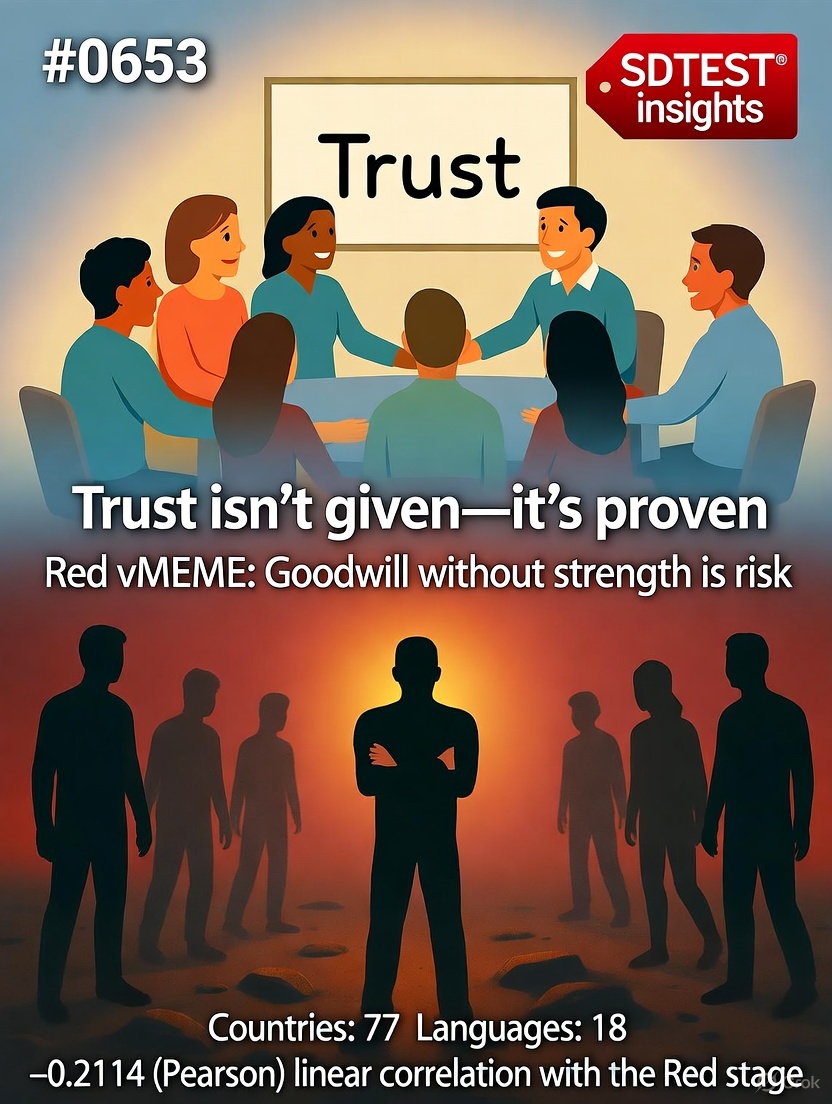
This negative correlation of -0.2114 between "Most people can be trusted" and the Red stage offers striking insights when viewed through the lens of the Red value system:
Organizational Perspective:
Organizations operating within the Red mindset might interpret this correlation as:
- Validation of their power-based philosophy, where trust is seen as a dangerous weakness that allows competitors to exploit and conquer the organization
- Confirmation that their survival-focused culture correctly assumes everyone is seeking to dominate, making trust a liability that threatens organizational power and control
- Evidence supporting their belief that organizations survive through force, intimidation, and constant vigilance against betrayal rather than through naive trust in others
These organizations might respond by:
- Implementing aggressive surveillance and control systems that assume all employees and competitors will betray the organization if given the opportunity
- Creating cultures of fear and dominance where loyalty is enforced through threats and demonstrations of power rather than trust
- Establishing hierarchies based on ruthless competition, where showing trust signals weakness that invites attack and exploitation
Team Perspective:
Teams operating from a Red mindset might approach this correlation by:
- Viewing it as affirmation that their competitive, dog-eat-dog team dynamics correctly recognize that teammates are really rivals waiting to stab you in the back
- Interpreting it as support for their belief that team survival requires constant displays of dominance and vigilance against betrayal from within
- Seeing it as validation for their aggressive culture, where trust is foolishness and every interaction is a potential power struggle
These teams might respond by:
- Creating team environments where members constantly test and challenge each other to prove strength and identify potential threats
- Establishing dynamics where alliances are temporary and purely strategic, never based on genuine trust or loyalty
- Implementing systems where team members guard their resources, information, and victories jealously against potential theft by rivals
Individual Perspective:
Individuals aligned with the Red value system might interpret this correlation as:
- Personal validation of their instinct that trusting others is sucker behavior that only the weak and naive fall for
- Evidence supporting their survival strategy of assuming everyone is a potential enemy or a tool for their own advancement
- Confirmation that their paranoid vigilance and refusal to trust protect them from inevitable betrayal and exploitation
These individuals might respond by:
- Approaching every relationship as a potential power struggle where trusting others creates exploitable vulnerability
- Using others strategically for immediate gain while assuming they're doing the same in return
- Maintaining constant readiness to betray or attack before being betrayed, viewing trust as a dangerous delusion
This correlation, viewed through the Red lens, suggests that those operating at the Red level see trust as fundamentally incompatible with survival and power acquisition.
The reasons why people with strong Red values are less likely to believe most people can be trusted could include:
- Survival Paranoia: Understanding the world as a battlefield where trusting others means lowering your guard and inviting attack or exploitation
- Projection of Intent: Assuming others operate with the same self-centered, exploitative mindset, making trust irrational and dangerous
- Power Protection: Recognizing that trust creates vulnerability that stronger competitors will ruthlessly exploit to seize dominance
- Immediate Threat Focus: Living in constant awareness of potential betrayal and attack, making trust seem like naive weakness
- Competitive Worldview: Viewing all relationships through a zero-sum lens where others' gains come at your expense, making trust self-destructive
This correlation prompts us to consider how power-focused value systems fundamentally reshape perceptions of human nature and social relationships. It raises questions about the cyclical nature of distrust in environments dominated by Red consciousness.
Ultimately, this correlation highlights the profound interplay between survival consciousness, power dynamics, and social trust. In Red environments, the inability to trust others might reflect not just personal paranoia but a rational adaptation to contexts where dominance, exploitation, and betrayal are indeed prevalent survival strategies, creating self-reinforcing cycles where distrust breeds the very predatory behavior that justifies continued distrust, trapping individuals and organizations in perpetual combat rather than cooperative progress.
In our analysis of the poll "Oxford Happiness Survey," we found an intriguing positive linear correlation that warrants closer examination:
0.0742 (Pearson) between the I laugh a lot / Moderately Disagree and the Blue stage.
The critical value of the correlation coefficient for a normal distribution, by William Sealy Gosset (Student), is r = 0.0493. Nevertheless, this positive linear correlation of 0.0742 meets the reliability criteria but does not necessarily imply causation.
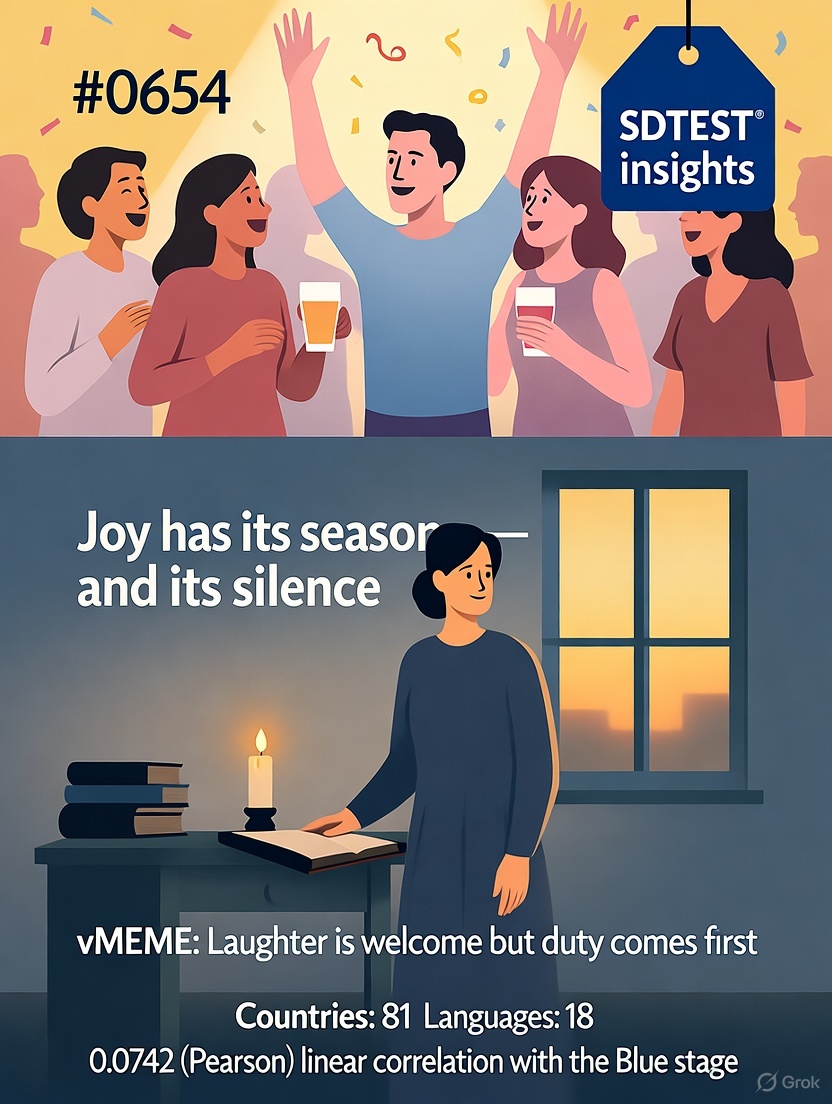
This positive correlation of 0.0742 between "I laugh a lot / Moderately Disagree" and the Blue stage offers revealing insights when viewed through the lens of the Blue value system:
Organizational Perspective:
Organizations operating within the Blue mindset might interpret this correlation as:
- Validation of their disciplined culture, where excessive laughter is viewed as frivolous behavior that undermines professional seriousness and institutional dignity
- Confirmation that their duty-focused environment correctly prioritizes solemn dedication to organizational mission over lighthearted emotional expression
- Evidence supporting their belief that proper institutional conduct requires maintaining composure and restraint rather than indulging in frequent laughter that could signal a lack of respect for authority
These organizations might respond by:
- Implementing workplace protocols that emphasize professional decorum, seriousness of purpose, and appropriate emotional restraint during work hours
- Creating organizational cultures where laughter is acceptable only in designated contexts and never at the expense of institutional dignity or hierarchical respect
- Establishing codes of conduct that define appropriate emotional expression aligned with traditional values of duty, responsibility, and moral seriousness
Team Perspective:
Teams operating from a Blue mindset might approach this correlation by:
- Viewing it as affirmation that serious team functioning requires emotional discipline and focus on duties rather than frivolous laughter and levity
- Interpreting it as support for their belief that excessive laughter indicates a lack of commitment to team responsibilities and institutional standards
- Seeing it as validation for maintaining proper team decorum, where laughter is controlled and appropriate to the seriousness of their mission
These teams might respond by:
- Establishing team norms that emphasize professional seriousness and discourage excessive laughter that might undermine team discipline
- Creating meeting protocols where levity is minimized in favor of focused attention on duties, responsibilities, and proper procedures
- Implementing team cultures where laughter is viewed with suspicion as potentially disrespectful to authority or indicative of insufficient dedication
Individual Perspective:
Individuals aligned with the Blue value system might interpret this correlation as:
- Personal validation that their restrained approach to emotional expression reflects proper moral character and disciplined self-control
- Evidence supporting their belief that frequent laughter suggests frivolity and a lack of seriousness about one's duties and responsibilities
- Confirmation that their emotional restraint demonstrates respect for institutional authority and commitment to traditional values of dignity
These individuals might respond by:
- Consciously limiting laughter and maintaining emotional composure as demonstrations of moral discipline and proper conduct
- Viewing those who laugh frequently as potentially lacking in seriousness, duty orientation, or respect for traditional values
- Practicing emotional restraint as a form of moral discipline that honors higher authority and institutional standards
This correlation, viewed through the Blue lens, suggests that those operating at the Blue level may see frequent laughter as incompatible with the seriousness, discipline, and moral focus required by their value system.
The reasons why people with strong Blue values are more likely to moderately disagree that they laugh a lot could include:
- Moral Seriousness: Believing that life's purpose involves solemn dedication to duty and righteousness rather than frivolous emotional expression
- Disciplined Restraint: Viewing emotional control and composure as virtues that reflect proper character development and moral training
- Hierarchical Respect: Understanding that excessive laughter might be perceived as disrespectful to authority figures or institutional dignity
- Duty Focus: Prioritizing responsibilities and obligations over personal pleasure or emotional indulgence, like frequent laughter
- Judgment of Levity: Viewing frequent laughter as potentially indicative of moral laxity, lack of seriousness, or insufficient commitment to proper conduct
This correlation prompts us to consider how order-focused value systems influence emotional expression and perceptions of appropriate behavior. It raises questions about the relationship between moral discipline, institutional loyalty, and emotional restraint in traditional societies.
Ultimately, this correlation highlights the complex interplay between duty orientation, emotional discipline, and behavioral norms. In Blue environments, reduced laughter might reflect not unhappiness but rather a conscious commitment to moral seriousness, institutional dignity, and the belief that proper conduct requires emotional restraint and focus on duties handed down by higher authority, where frequent laughter could be seen as incompatible with the solemn responsibility of living according to traditional moral codes and maintaining the order and discipline necessary for righteous individual and organizational functioning.
In our analysis of the poll "Algebra of Conscience" (by Vladimir Lefebvre), we found an intriguing negative linear correlation that warrants closer examination:
-0.2150 (Pearson) between the One must not give false evidence even to help an innocent person avoid jail / Strongly agree and the Orange stage.
The critical value of the correlation coefficient for a normal distribution, by William Sealy Gosset (Student), is r = 0.1642. Nevertheless, this negative linear correlation of -0.2150 meets the reliability criteria but does not necessarily imply causation.
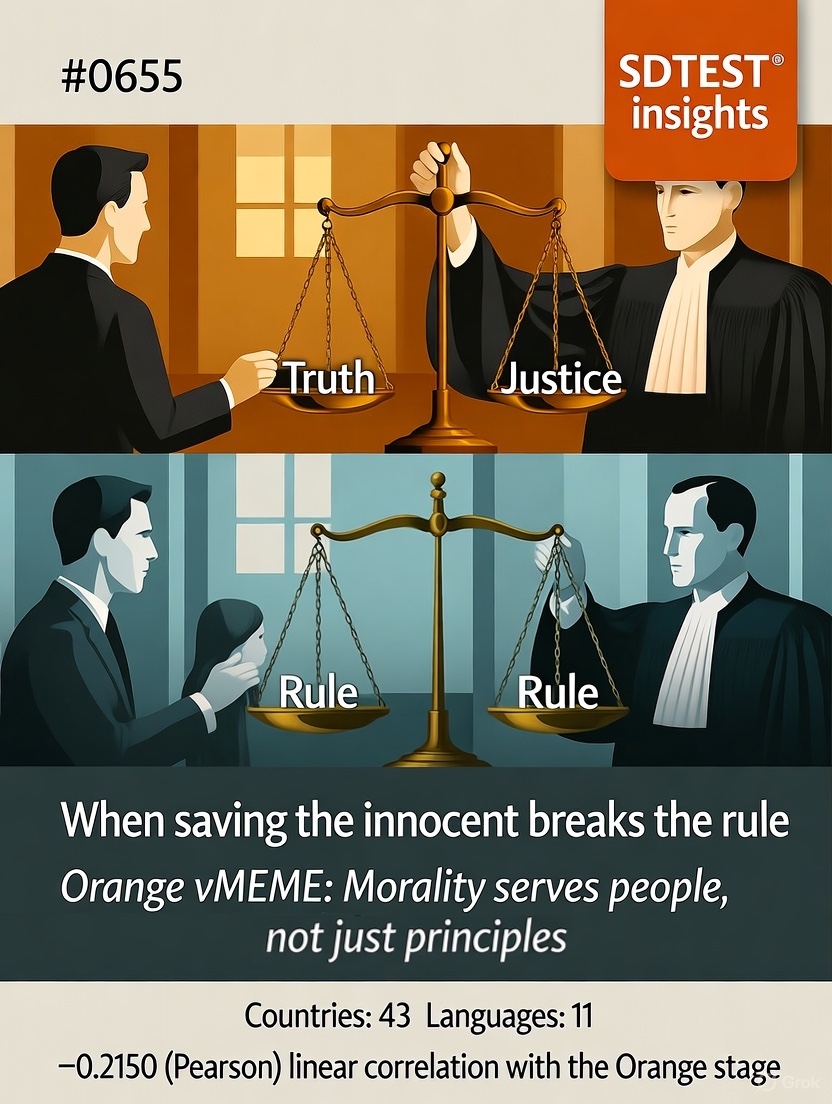
This negative correlation of -0.2150 between "One must not give false evidence even to help an innocent person avoid jail / Strongly agree" and the Orange stage offers revealing insights when viewed through the lens of the Orange value system:
Organizational Perspective:
Organizations operating within the Orange mindset might interpret this correlation as:
- Validation of their pragmatic, results-oriented approach, where rigid adherence to abstract rules can be counterproductive when those rules prevent achieving legitimate outcomes
- Confirmation that their rational analysis recognizes situations where strategic information management serves organizational interests and achieves justice more efficiently than strict rule compliance
- Evidence supporting their belief that intelligent organizations evaluate consequences and optimize strategies rather than blindly following moral absolutes that may produce unjust results
These organizations might respond by:
- Implementing sophisticated ethical frameworks that analyze outcomes and consequences rather than applying categorical moral rules without contextual evaluation
- Creating policies that emphasize achieving measurable justice and fairness outcomes over procedural rule compliance when the two conflict
- Developing decision-making systems where stakeholders analytically assess whether strict honesty serves or undermines legitimate organizational and societal goals
Team Perspective:
Teams operating from an Orange mindset might approach this correlation by:
- Viewing it as an affirmation that high-performing teams sometimes strategically manage information to achieve fair outcomes and competitive advantage
- Interpreting it as support for their belief that teams operating with rigid honesty rules may handicap themselves against competitors using more sophisticated information strategies
- Seeing it as validation for pragmatic team cultures where results matter more than absolute adherence to rules that might prevent achieving justice
These teams might respond by:
- Establishing team decision-making processes that analytically evaluate when truth-telling serves team interests and when strategic communication produces better outcomes
- Creating performance cultures where team members are evaluated on effectiveness in achieving goals rather than on rule compliance alone
- Implementing team norms that distinguish between situations requiring strict honesty and situations where strategic information management serves legitimate team purposes
Individual Perspective:
Individuals aligned with the Orange value system might interpret this correlation as:
- Personal validation of their rational analysis that absolute honesty rules can sometimes prevent achieving genuine justice and fair outcomes
- Evidence supporting their pragmatic approach to ethics, where consequences and results matter more than categorical moral principles
- Confirmation that their sophisticated thinking transcends simplistic black-and-white moral rules in favor of contextual ethical analysis
These individuals might respond by:
- Developing personal ethical frameworks based on outcome analysis rather than absolute principles that might produce unjust results
- Using their analytical capabilities to evaluate when strategic honesty serves their goals versus when it creates unnecessary barriers
- Viewing themselves as operating at a more sophisticated ethical level than those bound by rigid moral rules
This correlation, viewed through the Orange lens, suggests that those operating at the Orange level may evaluate moral rules through pragmatic, consequentialist frameworks rather than categorical imperatives.
The reasons why people with strong Orange values are less likely to strongly agree that false evidence is always wrong could include:
- Consequentialist Analysis: Evaluating moral rules based on outcomes rather than absolute principles. If false evidence produces justice, the rule may be questioned
- Rational Pragmatism: Believing that intelligent people should analyze situational context rather than apply rules blindly, regardless of consequences
- Systems Optimization: Understanding that rigid rule-following sometimes prevents optimal solutions that serve legitimate goals more effectively
- Results Orientation: Prioritizing achievement of fair outcomes over procedural correctness when the two conflict
- Intellectual Sophistication: Viewing categorical moral rules as unsophisticated compared to nuanced ethical analysis based on specific circumstances
This correlation prompts us to consider how achievement-focused value systems approach fundamental moral principles. It raises important concerns about consequentialist reasoning and the erosion of ethical boundaries.
However, it should be noted that a critical concern: this correlation and Orange-stage interpretation warrant serious ethical scrutiny. While Orange consciousness offers valuable rational analysis, the reasoning presented here risks normalizing the fabrication of evidence, which fundamentally undermines justice systems, regardless of intentions.
The empirical reality is that allowing "strategic" false evidence, even with good intentions, creates cascading harm: it corrupts evidence integrity, enables manipulation of outcomes, and ultimately makes justice less reliable for everyone. History consistently shows that exceptions to evidential honesty become normalized, creating systems, which the powerful manipulate evidence while the vulnerable suffer worse injustice.
The distinction between rational pragmatism and rationalization matters here. True consequentialist analysis must account for systemic effects, and false evidence demonstrably produces worse long-term consequences for justice systems than strict honesty, even when individual cases seem to justify exceptions.
Ultimately, this correlation highlights how results-oriented consciousness can paradoxically undermine the achievement of genuine justice through erosion of foundational institutional integrity. In Orange environments, the lower strong agreement with absolute honesty principles might reflect sophisticated reasoning, but it may also reflect a concerning blind spot where achievement orientation overrides the recognition that reliable justice systems require uncompromising commitment to evidential truth.
In our analysis of the poll "Why People Resist Change" (by Siobhán McHale [1]), we found an intriguing positive linear correlation that warrants closer examination:
0.1221 (Pearson) between the Concern for co-workers and the Green stage.
The critical value of the correlation coefficient for a normal distribution, by William Sealy Gosset (Student), is r = 0.105. Nevertheless, this positive linear correlation of 0.1221 meets the reliability criteria but does not necessarily imply causation.
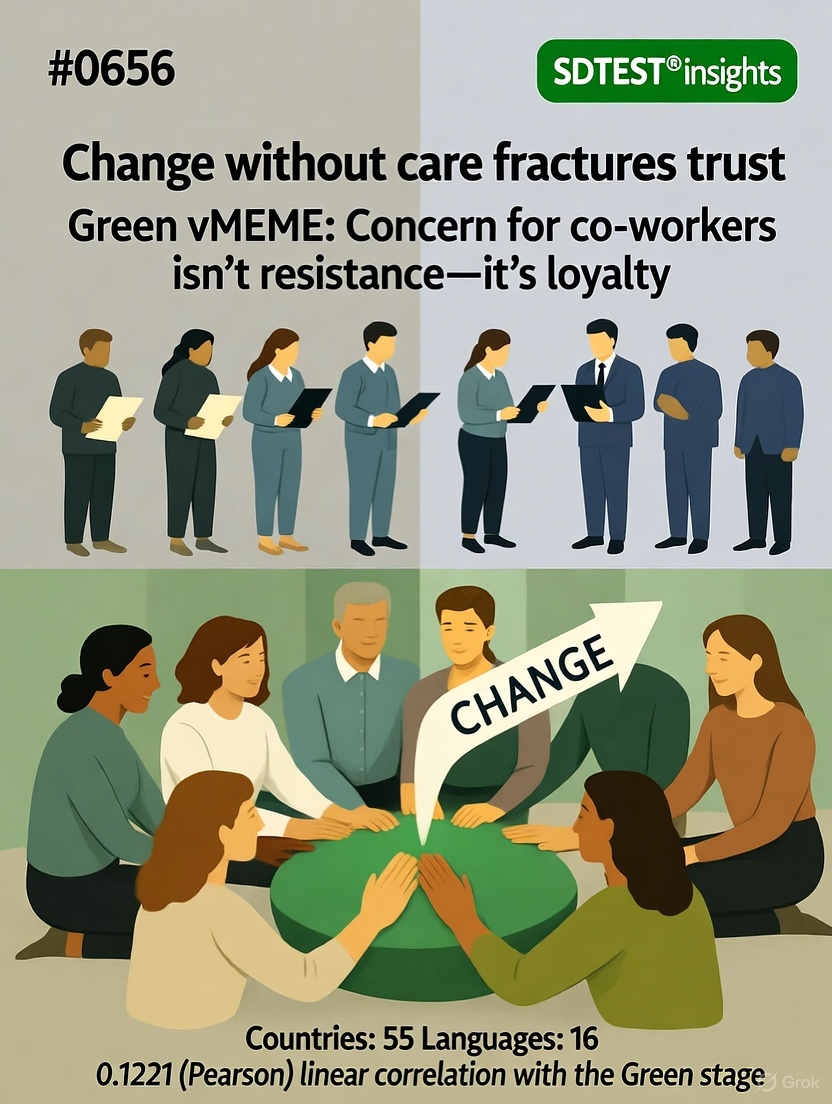
This positive correlation of 0.1221 between "Concern for co-workers" as a key factor in how change is handled and experienced, and the Green stage, offers meaningful insights when viewed through the lens of the Green value system:
Organizational Perspective:
Organizations operating within the Green mindset might interpret this correlation as:
- Validation of their holistic understanding that organizational change experienced through a lens of genuine care for colleagues transforms resistance into collective adaptation
- Confirmation that their inclusive, relationship-centered approach recognizes how concern for coworkers' wellbeing, fears, and transitions directly shapes how organizational change unfolds
- Evidence supporting their belief that sustainable change emerges from prioritizing relational harmony and collective emotional well-being over top-down implementation efficiency
These organizations might respond by:
- Implementing change management processes centered on peer support systems, dialogue circles, and collective sense-making that honor coworker relationships
- Creating transition support structures where concern for colleagues' emotional and practical needs guides how change is communicated and paced
- Developing organizational cultures where resistance to change is understood as an expression of legitimate concern for community wellbeing rather than as an obstruction to overcome
Team Perspective:
Teams operating from a Green mindset might approach this correlation by:
- Viewing it as an affirmation that team members naturally experience change through the lens of how it affects their colleagues' well-being and team cohesion
- Interpreting it as support for their understanding that collective concern for each other is the primary engine through which teams navigate transformation
- Seeing it as validation for team-centered change processes, where relationship maintenance and mutual care guide adaptation strategies
These teams might respond by:
- Establishing team practices where change discussions prioritize understanding how transitions affect each member's well-being and circumstances
- Creating psychological safety structures where team members can voice concerns about how change impacts colleagues without fear of judgment
- Implementing collaborative decision-making about change where team consensus emerges from genuine consideration of shared impacts and collective needs
Individual Perspective:
Individuals aligned with the Green value system might interpret this correlation as:
- Personal validation that their natural concern for coworkers is not peripheral but central to how they experience and adapt to organizational change
- Evidence supporting their belief that authentic change participation flows from a genuine connection to how change affects the people they work with
- Confirmation that their relational approach to professional life is sophisticated and necessary for navigating change healthily
These individuals might respond by:
- Actively considering how organizational changes affect their colleagues when forming their own responses and resistance points
- Engaging in change conversations that prioritize collective wellbeing and mutual support rather than individual survival or advantage
- Viewing their concern for coworkers as legitimate input into change processes rather than as emotional sentimentality to be overcome
This correlation, viewed through the Green lens, suggests that those operating at the Green level experience organizational change fundamentally through relationships and collective wellbeing rather than through individual impact alone.
The reasons why concern for coworkers is a key factor in how change is experienced in the Green stage could include:
- Interconnected Consciousness: Understanding that the individual experience of change is inseparable from how it affects the broader community and relationships
- Collective Well-being Prioritization: Recognizing that shared concern for mutual welfare is the foundation for cooperative adaptation rather than fragmented individual responses
- Relational Resilience: Believing that teams adapt most effectively when connected by genuine care and mutual support during transition periods
- Systems Awareness: Understanding how individual resistance to change often reflects legitimate concerns about collective impacts rather than personal obstruction
- Inclusive Decision-Making: Prioritizing dialogue processes where concern for all members' experiences shapes how change is implemented
This correlation prompts us to consider how community-focused consciousness reshapes organizational change dynamics toward relational and collective frameworks. It raises questions about whether genuine sustainability in organizational transformation requires prioritizing coworker concern and collective well-being.
Ultimately, this correlation highlights the profound interplay between relational consciousness, collective adaptation, and organizational change. In Green environments, concern for coworkers might be understood not as a sentimental distraction from change management but as the essential human mechanism through which communities navigate transformation together, recognizing that when people care authentically about how change affects their colleagues, resistance transforms into collaborative adaptation and organizational change becomes an opportunity for deepening community bonds while honoring shared well-being.
0.1862 (Pearson) between the Select office/remote and the Yellow stage.
The critical value of the correlation coefficient for a normal distribution, by William Sealy Gosset (Student), is r = 0.1597. Nevertheless, this positive linear correlation of 0.1862 meets the reliability criteria but does not necessarily imply causation.
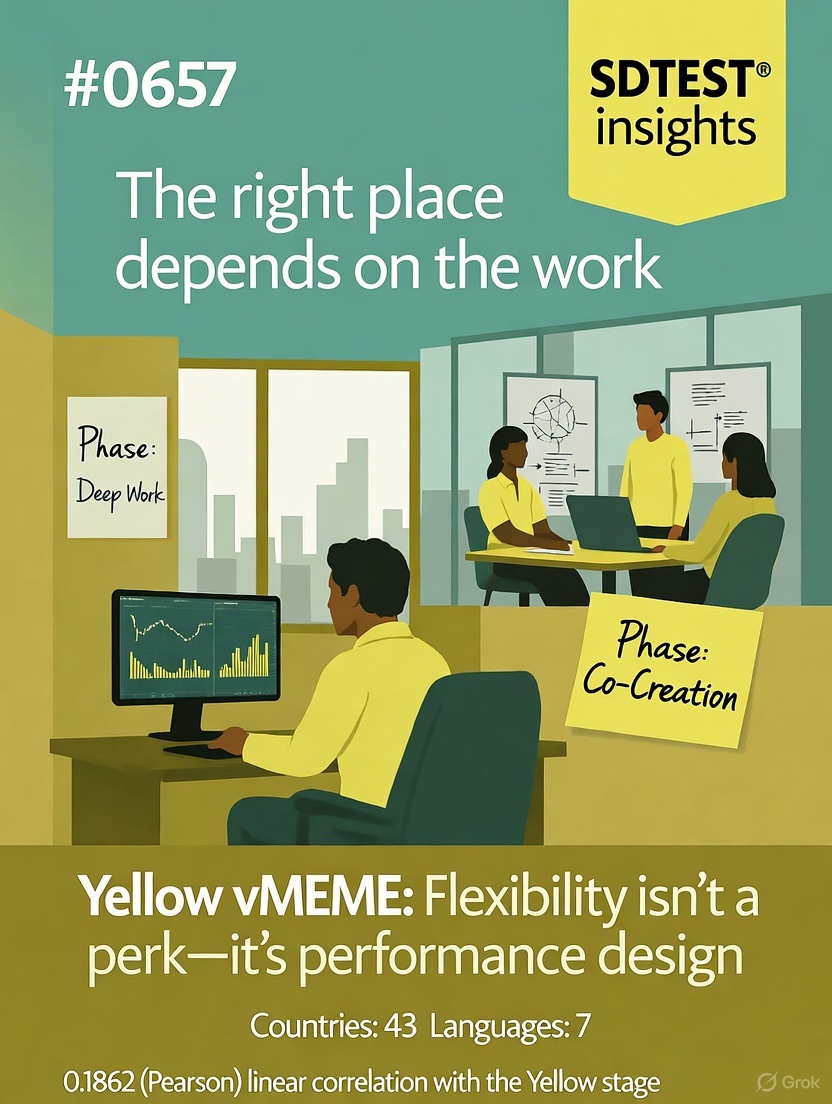
This positive correlation of 0.1862 between "Select office/remote" (location flexibility) as essential for IT specialists and the Yellow stage offers significant insights when viewed through the lens of the Yellow value system:
Organizational Perspective:
Organizations operating within the Yellow mindset might interpret this correlation as:
- Validation of their sophisticated understanding that location flexibility enables IT professionals to operate effectively across multiple contexts and developmental stages simultaneously
- Confirmation that their integrative approach recognizes how rigid location requirements constrain the adaptive capacity and systems awareness that Yellow-stage professionals require
- Evidence supporting their belief that allowing professionals to modulate their work environment optimizes their ability to synthesize complex information and navigate multifaceted technical ecosystems
These organizations might respond by:
- Implementing flexible work arrangements as standard infrastructure that enables professionals to access the environmental conditions supporting their integrative thinking
- Creating distributed team architectures that leverage location flexibility as a strategic advantage for complex problem-solving across systems
- Developing sophisticated remote collaboration frameworks that preserve the nuanced communication necessary for second-tier consciousness integration
Team Perspective:
Teams operating from a Yellow mindset might approach this correlation by:
- Viewing it as affirmation that their team's capacity for adaptive complexity requires members to operate from contexts that optimize their individual development and perspective integration
- Interpreting it as support for their understanding that location flexibility enables team members to balance multiple responsibilities and developmental needs simultaneously
- Seeing it as validation for distributed team models where professionals maintain autonomy while remaining connected to collective intelligence and collaborative complexity
These teams might respond by:
- Establishing team norms that honor location flexibility as essential infrastructure for second-tier functioning rather than as a perk or concession
- Creating collaborative practices that integrate asynchronous communication, temporal flexibility, and spatial autonomy into sophisticated team processes
- Implementing decision-making systems that preserve integrative consciousness regardless of where team members are physically located
Individual Perspective:
Individuals aligned with the Yellow value system might interpret this correlation as:
- Personal validation that location flexibility enables them to maintain the contextual adaptability and multi-perspectival awareness their integrative consciousness requires
- Evidence supporting their need for autonomy in managing environmental conditions that support their capacity to hold multiple perspectives simultaneously
- Confirmation that their requirement for location choice reflects sophisticated developmental maturity rather than resistance to organizational commitment
These individuals might respond by:
- Viewing location flexibility as essential infrastructure for their ability to synthesize complex systems and maintain integrative consciousness
- Prioritizing employers offering genuine location autonomy as prerequisites for their optimal functioning
- Using their freedom to modulate between collaborative and solitary environments as necessary for their intellectual and developmental work
This correlation, viewed through the Yellow lens, suggests that those operating at the Yellow level recognize location flexibility as enabling rather than optional for their integrative functioning.
The reasons why IT professionals with strong Yellow values prioritize location flexibility could include:
- Contextual Optimization: Understanding that different locations support different types of cognitive work, some requiring focused systems analysis, others requiring collaborative integration
- Developmental Flexibility: Recognizing that their ongoing personal and professional growth requires the ability to adjust environmental conditions as their needs evolve
- Systems Integration: Needing access to diverse information sources and networking contexts that rigid location requirements would constrain
- Multi-Perspective Access: Benefiting from exposure to different communities, work styles, and professional ecosystems that location flexibility enables
- Adaptive Resilience: Understanding that flexible arrangements enable them to navigate life complexity while maintaining professional effectiveness
This correlation prompts us to consider whether location flexibility functions differently for developmentally advanced consciousness than for earlier stages. It raises questions about whether integrative thinking requires a different organizational infrastructure than conventional work arrangements provide.
However, it should be noted that a realistic consideration: While Yellow-stage professionals may genuinely benefit from location flexibility for legitimate reasons, asynchronous problem-solving, accessing diverse perspectives, and managing complex life circumstances, this correlation also risks becoming a rationalization for avoiding organizational commitment or team interdependence.
True Yellow consciousness should balance autonomy needs with genuine contribution to collective team function. Location flexibility becomes healthy when it serves integrative work and team effectiveness, but problematic when it masks avoidance of challenging collaboration or commitment. The distinction matters: evolved consciousness typically deepens relational capacity, not diminishes it.
Ultimately, this correlation highlights how integrative consciousness reshapes workplace arrangements around autonomy and contextual optimization. In Yellow environments, location flexibility might be understood not as individual preference but as infrastructure enabling IT professionals to maintain the adaptive, multi-perspectival consciousness essential for navigating complex technical systems, provided it remains in service of both personal development and genuine team contribution.
In our analysis of the poll "Ageism in life," we found an intriguing positive linear correlation that warrants closer examination:
0.3607 (Pearson) between the Yes, I have seen someone being treated differently because of their age and the Turquoise stage (USA, English).
The critical value of the correlation coefficient for a normal distribution, by William Sealy Gosset (Student), is r = 0.2584. Nevertheless, this positive linear correlation of 0.3607 meets the reliability criteria but does not necessarily imply causation.
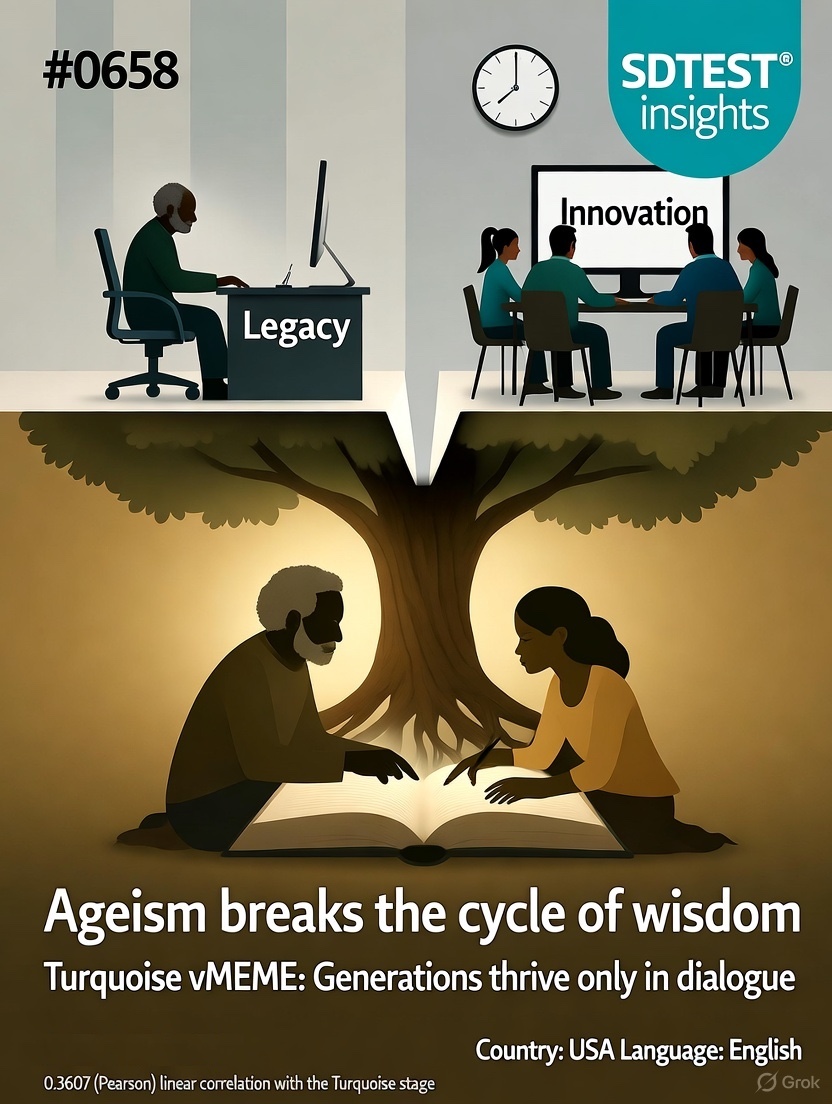
This positive correlation of 0.3607 between "Yes, I have seen someone being treated differently because of their age" and the Turquoise stage offers significant insights when viewed through the lens of the Turquoise value system:
Organizational Perspective:
Organizations operating within the Turquoise mindset might interpret this correlation as:
- Validation of their holistic systems awareness that recognizes age-based discrimination as a manifestation of fragmented consciousness disconnected from the interdependence of all life stages
- Confirmation that their ecological perspective enables them to perceive how ageist practices harm the entire organizational ecosystem by devaluing the wisdom and contribution of different generational expressions
- Evidence supporting their belief that organizations committed to genuine sustainability must honor the sacred role of elders and recognize how age discrimination contradicts the principle of interconnected wholeness
These organizations might respond by:
- Implementing comprehensive age-inclusion practices that actively celebrate generational diversity as essential for organizational wisdom and intergenerational sustainability
- Creating mentorship structures that honor the knowledge transmission between age groups as a sacred reciprocal exchange rather than transactional hiring
- Developing organizational cultures where age diversity is viewed as spiritual richness, reflecting the cosmic cycles of human development and contribution
Team Perspective:
Teams operating from a Turquoise mindset might approach this correlation by:
- Viewing it as an affirmation that teams attuned to interconnected consciousness naturally recognize and name age discrimination as a violation of the web linking all life stages
- Interpreting it as support for their holistic understanding that excluding or devaluing members based on age fragments the collective wisdom and resilience that team ecosystems require
- Seeing it as validation for their commitment to intergenerational collaboration as spiritual practice and ecological necessity
These teams might respond by:
- Establishing team practices that explicitly honor the unique contributions and perspectives each age group brings to collective intelligence
- Creating dialogue spaces where ageism is openly named and examined as a symptom of fragmented consciousness requiring healing
- Implementing collaborative structures that facilitate generational wisdom-sharing and recognize age diversity as a portal to deeper team consciousness
Individual Perspective:
Individuals aligned with the Turquoise value system might interpret this correlation as:
- Personal validation that their heightened awareness of age discrimination reflects evolved consciousness, recognizing injustice in the interconnected web
- Evidence supporting their spiritual understanding that respecting all life stages is fundamental to honoring the sacred cycles and roles within the human community
- Confirmation that their commitment to naming ageism serves collective healing and evolution toward genuine inclusion
These individuals might respond by:
- Actively witnessing, naming, and challenging age-based discrimination when they encounter it as a spiritual responsibility to maintain the integrity of interconnected systems
- Engaging in intergenerational connection and learning as a spiritual practice that honors the sacred wisdom each age brings
- Using their recognition of ageism as a catalyst for broader cultural transformation toward honoring human dignity across all life stages
This correlation, viewed through the Turquoise lens, suggests that those operating at the Turquoise level possess heightened awareness of systemic discrimination rooted in their perception of interconnected wholeness.
The reasons why people with strong Turquoise values are more likely to recognize and name age-based discrimination could include:
- Systemic Consciousness: Understanding age discrimination as a violation of the interconnected web, where all generations contribute essential roles to collective health
- Lifecycle Wisdom: Recognizing that each age represents a sacred stage of human development with unique contributions devalued through ageist systems
- Intergenerational Responsibility: Viewing protection of elders and youth as a spiritual obligation reflecting commitment to planetary wellbeing across time
- Holistic Seeing: Perceiving how ageism fragments organizational and social ecosystems by excluding the wisdom and experience that different ages embody
- Healing Orientation: Understanding that naming injustice is essential to transforming systems toward genuine sustainability and inclusion
This correlation prompts us to consider whether advanced consciousness naturally develops a heightened capacity to recognize systemic injustice. It raises important questions about the relationship between holistic awareness and social justice consciousness.
Additionally, while naming ageism serves important justice purposes, the most profound change likely requires more than awareness; it requires concrete structural changes to hiring, promotion, and workplace practices. Naming injustice without action toward systemic transformation can sometimes become performative rather than generative.
Ultimately, this correlation highlights how holistic, interconnected consciousness may enable recognition of systemic injustice patterns. In Turquoise environments, the capacity to perceive and name age-based discrimination reflects evolved awareness of how fragmented systems harm the collective ecosystem and potentially signals the responsibility to move from witness to active agent of transformation toward genuinely inclusive, intergenerational organizations and societies.
What insights do you gain from today's correlation? How might we study this relationship more carefully before deducing causation?
We welcome respectful and wise perspectives! Stay tuned every week as we share more results and insights.
After login or registration, free access to the poll results in the FAQ section.
[1] www.linkedin.com/in/mchalesiobhan
2025.10.19
FearpersonqualitiesprojectorganizationalstructureRACIresponsibilitymatrixCritical ChainProject Managementfocus factorJiraempathyleadersbossGermanyChinaPolicyUkraineRussiawarvolatilityuncertaintycomplexityambiguityVUCArelocatejobproblemcountryreasongive upobjectivekeyresultmathematicalpsychologyMBTIHR metricsstandardDEIcorrelationriskscoringmodelGame TheoryPrisoner's Dilemma
ভ্যালারি কোসেনকো
পণ্যের মালিক SaaS SDTEST®৷
ভ্যালেরি 1993 সালে একজন সামাজিক শিক্ষাবিদ-মনোবিজ্ঞানী হিসাবে যোগ্য হয়েছিলেন এবং তারপর থেকে প্রকল্প পরিচালনায় তার জ্ঞান প্রয়োগ করেছেন।
ভ্যালেরি 2013 সালে স্নাতকোত্তর ডিগ্রি অর্জন করেন এবং প্রকল্প এবং প্রোগ্রাম ম্যানেজারের যোগ্যতা অর্জন করেন। তার মাস্টার্স প্রোগ্রাম চলাকালীন, তিনি প্রজেক্ট রোডম্যাপ (GPM ডয়েচে গেসেলশ্যাফ্ট ফর প্রজেক্টম্যানেজমেন্ট ই. ভি.) এবং স্পাইরাল ডায়নামিক্সের সাথে পরিচিত হন।
ভ্যালেরি V.U.C.A এর অনিশ্চয়তা অন্বেষণের লেখক। মনোবিজ্ঞানে স্পাইরাল ডায়নামিক্স এবং গাণিতিক পরিসংখ্যান ব্যবহার করে ধারণা এবং 38টি আন্তর্জাতিক ভোট।








